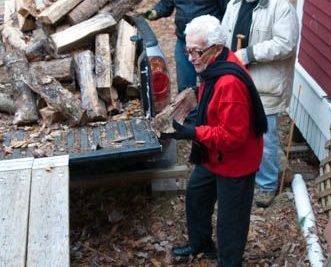As educators, therapists and coaches it can be easy to minimize the power of our words on someone’s life. Here is a cautionary tale mostly quoted directly from a phone call I had with my mother when she was 100 years old.
“When I went to kindergarten I used to love to wear my red midi. I was so happy when I wore it. I remember one day, I think maybe there was a new kid in the class – not sure – but the teacher needed to fix some of the desks.Do you remember those old desks that were bolted to the floor and you had to adjust them by unscrewing some bolts so kids of different sizes could fit?My teacher asked me to come to her desk and told me to go up to the eighth grade and say: “Please send some boys to help fix the desks.” I still remember those words, because she said I must say them exactly as she told me.I felt so important and proud, as I walked to the eighth grade. I was wearing my red midi, plus I got to go to the older kids’ class on an important errand. I hurried up to the eighth grade. I was a bit nervous as I knocked on the classroom door. The teacher motioned for me to come in and I quietly went up to her and softly repeated the exact words I was told to say: “Please send some boys to help fix the desks.”The problem was I had a very pronounced lisp at the time, so you can imagine what it sounded like.The teacher then turned to the whole class and loudly repeated exactly what I had said – mimicking my lisp.All the big kids laughed at me. I got as red as my midi.When I went home and told my mother – who was recovering from typhoid at the time – she was really angry. I don’t know if she spoke to the teacher or not, but I do know she tried to fix my lisp by drilling me over-and-over again with lists of words that began with the letter ‘s’: “Sally sat by the seashore sifting seashells.”
That time in Kindergarten affected my whole life – it was always in the back of my brain. Because of my nursing training, I was active on the Public Health Board in our town. They really wanted me to be chairman. I resigned before they could appoint me because I was afraid of the public speaking that would come with the job. Later, others wanted me to be Vice Chairman of the Republican Party in town, and I backed down for the same reason. I said no thanks because I couldn’t face the public speaking. Even back in grammar school I was on the swimming team and backed down when they wanted me to be captain. Same thing in high school with cheerleading. I could not face speaking in public, because of what that teacher did. I did fine door-to-door canvassing for Taft to try to get him elected, but I could not face the public speaking – because of what happened with that teacher.”
You can see how the power of a short sentence spoken by a Kindergartener in 1920 or 1921 limited my mother’s whole life. It was clear 95 years after it happened that it still haunted her because she described it to me in such detail and with a good deal of emotion. (By the way, it was the first time I had heard the story, and I had to quietly hold down my anger and sadness so she could complete it.)
How could it be that a nine-word sentence, mimicked in 1920, limited someone’s whole life? Here is a critical point – this is not pathology – it is the brain doing what it is supposed to do.
As neuroscience begins to inform the fields of education and psychology it is showing us how the brain functioning perfectly can have a negative influence on our lives. It is also showing us what we can do about it.
We know from the research that the older parts of the brain trying to protect us by attending to and remembering negative events (Porges, 2017, Siegel, 2012). Many believe that the brain evolved to attend to and remember negative events in order to teach us to be alert to possible future threats (Cozolino, 2013). For example, it is plausible that those prehistoric humans who were able to survive had brains that evolved to remember where they experienced the fear of meeting a predator leading to avoidance of that spot. Once rudimentary language developed they probably described it to others who also remembered the story and avoided the predator, leading to the survival of Homo Sapiens.
The world has changed and there are rarely predators in the prehistoric sense, but the brain still works pretty much the same way. So my mother’s brain – trying to help her “survive” – used her Kindergarten memory to remind her to avoid public speaking.
How might we overcome our own “Kindergarten memories”?
The research by Fredrickson (2009) with individuals and Julie and John Gottman (2007) with couples point to needing somewhere between 3 to 5 positive statements or experiences to override one negative one. Eventually, the “disconfirming” experiences can create new memories and a different felt sense. Of course, since we can compound the original experience with self-doubt, internal shaming, and more, some humiliations or negative experiences need more attention, untangling, and healing.
Imagine if my mother had been able to do some public speaking by using her prefrontal cortex to override the fear that rose from the older parts of her brain that were just trying to protect her from predators. Imagine if she could have done that with a receptive, supportive audience. Clearly, her communities saw her leadership and contributions in ways she didn’t; they are likely to have been that audience.
Imagine that her attempts were successful enough, and she received encouragement and positive regard each time. How many public talks would it have taken to “rewire” that Kindergarten memory – and how many different life opportunities could she have taken?
Take a few minutes and reflect on your own “Kindergarten memories.” Do you have some early events that you want to stop feeling constrained by? How might you create a supportive opportunity to address and shift these?
References:
Cozolino, L. (2013). The social neuroscience of education: Optimizing attachment & learning in the classroom. New York, W.W. Norton & Company, Inc.
Fredrickson, B. (2009). Positivity: Top-Notch research reveals the upward spiral that will change your life. New York, Crown Publishing Group.
Gottman, J., Schwartz-Gottman, J. & DeClair, J. (2007). Ten lessons to transform your marriage: America’s love lab experts share their strategies for strengthening your relationship. New York: Crown Publishing Group.
Siegel, D. (2012). The developing mind. How relationships and the brain interact to shape who we are. New York: Guilford Press.

